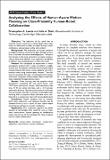Analyzing the Effects of Human-Aware Motion Planning on Close-Proximity Human-Robot Collaboration
Author(s)
Lasota, Przemyslaw Andrzej; Shah, Julie A.
DownloadLasota-2014-Analyzing the effects.pdf (944.9Kb)
PUBLISHER_CC
Publisher with Creative Commons License
Creative Commons Attribution
Terms of use
Metadata
Show full item recordAbstract
Objective: The objective of this work was to examine human response to motion-level robot adaptation to determine its effect on team fluency, human satisfaction, and perceived safety and comfort.
Background: The evaluation of human response to adaptive robotic assistants has been limited, particularly in the realm of motion-level adaptation. The lack of true human-in-the-loop evaluation has made it impossible to determine whether such adaptation would lead to efficient and satisfying human–robot interaction.
Method: We conducted an experiment in which participants worked with a robot to perform a collaborative task. Participants worked with an adaptive robot incorporating human-aware motion planning and with a baseline robot using shortest-path motions. Team fluency was evaluated through a set of quantitative metrics, and human satisfaction and perceived safety and comfort were evaluated through questionnaires.
Results: When working with the adaptive robot, participants completed the task 5.57% faster, with 19.9% more concurrent motion, 2.96% less human idle time, 17.3% less robot idle time, and a 15.1% greater separation distance. Questionnaire responses indicated that participants felt safer and more comfortable when working with an adaptive robot and were more satisfied with it as a teammate than with the standard robot.
Conclusion: People respond well to motion-level robot adaptation, and significant benefits can be achieved from its use in terms of both human–robot team fluency and human worker satisfaction.
Application: Our conclusion supports the development of technologies that could be used to implement human-aware motion planning in collaborative robots and the use of this technique for close-proximity human–robot collaboration.
Date issued
2015-01Department
Massachusetts Institute of Technology. Department of Aeronautics and AstronauticsJournal
Human Factors: The Journal of the Human Factors and Ergonomics Society
Publisher
Sage Publications
Citation
Lasota, P. A., and J. A. Shah. “Analyzing the Effects of Human-Aware Motion Planning on Close-Proximity Human-Robot Collaboration.” Human Factors: The Journal of the Human Factors and Ergonomics Society 57, no. 1 (January 21, 2015): 21–33. © 2015 Human Factors and Ergonomics Society
Version: Final published version
ISSN
0018-7208
1547-8181